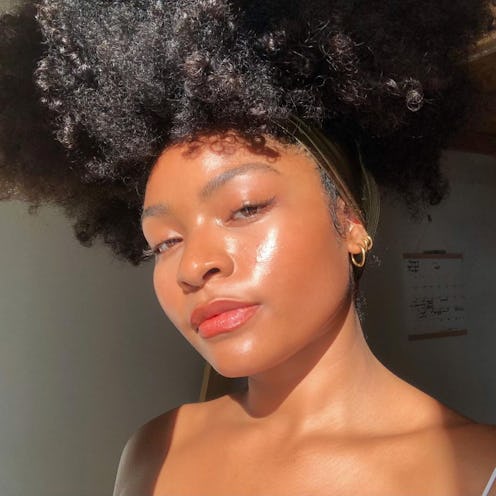Beauty
TikTok Says "Mewing" Will Sculpt Your Jawline — But Does It Work?
Here’s the unfiltered truth.
TikTok is in a tizzy over something called “mewing.” Supposedly, doing a simple tongue exercise can result in a more defined jawline. Sounds appealing — especially since it’d be easier than doing gua sha every single day for the same result. But is it too good to be true? Or does mewing work to sculpt your jawline and make your face look snatched?
The practice of mewing involves lifting your tongue to the roof of your mouth, closing your lips, and... that’s it. By this mere repositioning of your tongue, TikTok users believe you can improve the appearance of your jawline. And they’re not completely off: As it turns out, mewing is technically the MEAW technique used in orthodontics to shape children’s jaws and face shape as they grow. (Yeah, it’s not exactly glamorous.) It also has a lot to do with breathing properly — so there’s a high chance you’re mewing right now without even realizing it.
“We need oxygen every moment, so correct breathing is critical for the development of the face, mouth, and teeth,” says Dr. Kami Hoss, dentist, board member at the UCLA School of Dentistry, and author of If Your Mouth Could Talk. He notes that you should be breathing through your nose, and your tongue should be gently resting on the roof of your mouth against the palate right behind your teeth. And your tongue plays a key role in the development of your face. “The whole mouth grows around your tongue, so it’s very critical for children [to breathe properly] because it really impacts their growth and development,” says Hoss.
That’s where mewing comes in. According to Hoss, it’s one of several tongue-toning exercises — that have been around for over 20 years now — prescribed to children or adults who have trouble breathing properly. “The physiology behind [mewing] is fairly simple — the floor of the mouth is composed of several muscles, one of which is called the mylohyoid muscle,” says Dr. Marina Gonchar, DMD, board certified orthodontist at Skin to Smile. “The muscle assists in swallowing and speech. Raising the tongue to the roof of the mouth contracts this muscle and elevates the floor of the mouth, which can be directly observed from the outside as an improvement of the appearance of the jawline.”
A scroll through the #mewing videos on TikTok shows some pretty impressive before and after photos of users’ jawlines — but orthodontists say that the tongue exercise isn’t actually as mind-blowingly effective as it might look on social media. “Myofunctional therapy exercises [like mewing] often require bulky appliances and months of treatment to achieve any actionable results, and they are at best minimal,” says Gonchar. “It’s unlikely that repositioning your tongue a few minutes a day will have a significant or permanent change in your jaw structure.” If you’re a child working with an orthodontist as your teeth grow in, that’s different. “On children, it makes a dramatic improvement because their faces are still growing,” says Hoss. “The shape of the nose, the lips, the jawline, and chin become more balanced.”
On the plus side? Try mewing if you want your jaw to look more defined in #fitpics. “Although it’s not going to give you long-lasting results, it can be utilized in the moment to improve the appearance of your jawline in photos,” says Gonchar, who recommends saying words like “sing” or “king” while your tongue is in the proper position for the most sculpted effect.
Studies referenced:
Tabancis, M. (2019). Multiloop edgewise archwire technique and denture frame analysis: a systematic review. Head & Face Medicine, 16. https://doi.org/10.1186/s13005-020-00247-x
Experts:
Dr. Kami Hoss, dentist, board member at the UCLA School of Dentistry, and author of If Your Mouth Could Talk
Dr. Marina Gonchar, DMD, board certified orthodontist at Skin to Smile
This article was originally published on
